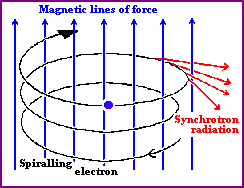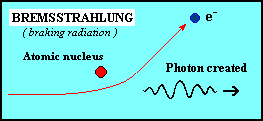For Educators
Continuum Emission

Just like visible light, with its range of energies from red to blue, X-rays have a continuum, or a range of energies associated with it. X-rays usually range in energy from around 0.5 keV up to around 1000 keV.
Like line emission, continuum X-ray emission involves charged particles. Continuum emission is a result of the acceleration of a population of charged particles. All X-ray sources contain such particles. These particles must be at least partially ionized - their electrons need to be unbound from their nuclei to be free to zip around when they are heated to extreme temperatures. For an electron to radiate X-rays, the gas containing the electron must have extreme conditions, such as temperatures of millions of degrees, super-strong magnetic fields, or the electrons themselves must be moving at nearly the speed of light. Extreme conditions can be found in disks of matter orbiting black holes or in supernova remnants. Strong magnetic fields, like those created in the wake of a supernova explosion, can also accelerate fast moving ions in spirals around the field lines to the point of X-ray emission. Electrons can be accelerated to nearly the speed of light in the shockwave created by a supernova explosion.
There are three mechanisms that will produce continuum X-ray emission. They are Synchrotron Radiation, Bremsstrahlung, and Compton Scattering. Because the populations of electrons have a continuous range of energies, and they can be accelerated through a range of energies, the radiation produced is continuous, and not at the discreet energies of line emission.

courtesy of University of Hertfordshire | Sychrotron radiation is emitted when a fast electron interacts with a magnetic field. A magnetic field in an area an electron is traveling in will cause the electron to change direction by exerting a force on it perpendicular to the direction the electron is moving. As a result, the electron will be accelerated, causing it to radiate electromagnetic energy. This is called magnetic bremsstrahlung or synchrotron radiation (after radiation observed from particle accelerators by that name). If the electrons and the magnetic field are energetic enough, the emitted radiation can be in the form of X-rays. |
|
Bremsstrahlung occurs when an electron passes close to a positive ion, and the strong electric forces cause its trajectory to change. The acceleration of the electron in this way causes it to radiate electromagnetic energy - this radiation is called bremsstrahlung, (literally, from the German meaning 'braking radiation'). Thermal bremsstrahlung occurs in a hot gas, where many electrons are stripped from their nuclei, leaving a population of electrons and positive ions. If the gas is hot enough (millions of degrees Kelvin), this kind of radiation will primarily take the form of X-rays. |
 courtesy of University of Hertfordshire |

courtesy of University of Hertfordshire |
Comptonization is when a photon collides with an electron - the photon will either give up energy to or gain energy from the electron, changing the electron's velocity as a result. |
What Are Some Examples of This In Action?
Gas that is at about a million to 10 million degrees, such as the gas heated by a supernova explosion, produces most of its emission in X-rays from thermal Bremsstrahlung. Gas can be heated to these temperatures by the outward moving shock of a supernova explosion, or in an accretion disk around a black hole or neutron star. Synchrotron radiation can produce X-rays around supernova remnants (SNR), where the magnetic fields are strong and ions have been accelerated by the shock wave to high energies. X-rays produced by SNR require electrons with energies of about 104 GeV each (you would have to heat an electron to a temperature of about ten trillion degrees for it to have this much energy)! Synchrotron radiation and Compton scattered radiation are major components of the diffuse X-ray background and emission from active galaxies.
- Spectroscopy
- Understanding Atoms
- Previous: Line Emission
- Continuum Emission
- Next: Pulling It Together


